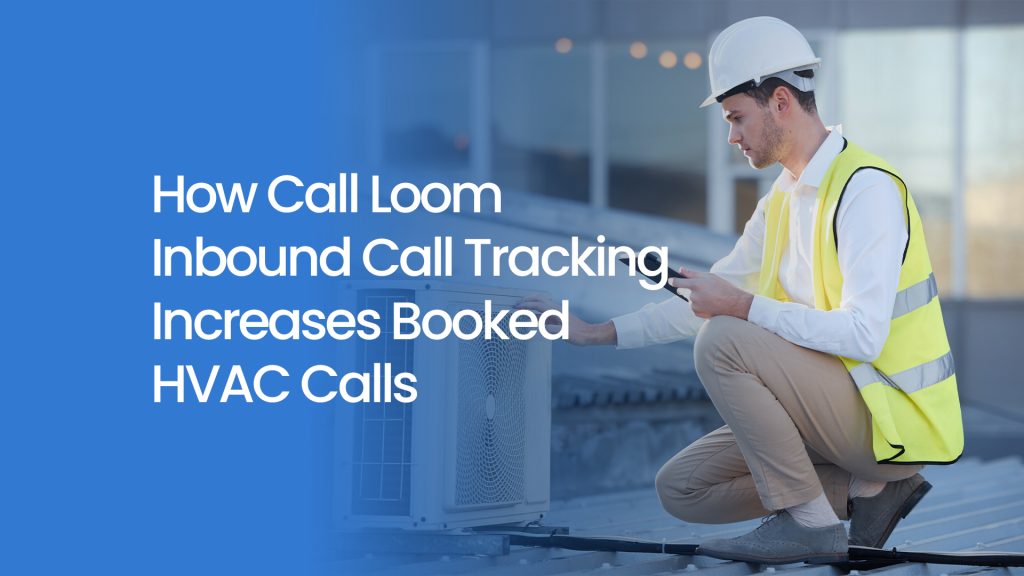Heat, outages, and tune-up promos push HVAC phones to spike in bursts, not evenly. You can see calls, but you can’t see which clicks became booked jobs or where the handoff failed. Call Loom inbound call tracking closes that gap for HVAC teams by keeping one clean thread from source to outcome. It tags whether a call came from your Google Business Profile, a “no-cool” service page, or a PPC ad, then records what happened next: estimate set, visit scheduled, or no-go.
Missed rings become owned callbacks with a due time. Duplicate follow-ups are blocked. Seven-day repeats expose “resolved” calls that weren’t. Pricing moments are marked for quick review. With that trail, you fund pages and campaigns that book visits, tighten after-hours recovery by morning, and coach the few moments that drive first-visit fixes. Same traffic. More booked HVAC jobs.
Call Loom Inbound Call Tracking in Modern HVAC Operations
HVAC businesses depend on inbound calls more than almost any other service industry. Over 70% of booked HVAC jobs still begin with a phone call, not a web form or chatbot. Yet most contractors can’t see the full path between marketing spend, phone interactions, and confirmed appointments. Calls are logged by one system, advertising by another, and dispatch outcomes by a third. The result: fragmented insight and recurring inefficiency.
Call Loom inbound call tracking was designed to unify those touchpoints. It maps each incoming call to its source, whether it came from a Google Local Services Ad, a “no-heat” landing page, or a Facebook campaign, and then follows it through to the recorded outcome: booked estimate, completed repair, or lost lead. That linkage gives HVAC owners operational truth instead of assumptions.
Sales Managers can finally answer the questions:
- Which campaigns deliver the highest booked-call rate?
- How many missed or duplicate follow-ups are eating technician hours?
- What patterns show up before repeat service calls within seven days?
Call Loom helps HVAC operations shift from reactive to data-guided. Ad budgets stop rewarding noise. Scheduling aligns with actual call peaks. And every customer conversation from first ring to dispatch becomes a measurable part of the workflow rather than an isolated event.
What Happens When HVAC Teams Start looking at their Call Patterns
Most HVAC phones don’t follow office hours. They spike before crews roll out and again when homeowners get home. Those missed calls, the ones everyone assumes are random aren’t random at all. Call Loom inbound call tracking lays those peaks out hour by hour through its Live Calls Streaming feature, helping HVAC teams see call volume as it happens and cover the hours that matter most.
- They Stop Losing Leads You Already Paid For
When a customer calls twice and two CSRs call them back, it feels like a hustle, but it’s a waste. Call Loom gives each lead a single owner and locks the record until the callback is done. No overlaps, no “I thought you called them.” Every ad click you paid for either books or closes the loop, and you can finally see which campaigns are pulling their weight.
2. They Catch the Quiet Problems Early
The repeat calls, the ones that come a week after a “resolved” job tell the truth. They show where information got lost: unclear pricing, missed confirmation, and wrong part ordered. Call Loom threads those together so you can hear what slipped and fix it in one training session, not a whole quarter later.
3. They End Up Running the Week, Not Chasing It
Once calls, callbacks, and outcomes all live in one thread, the week feels calmer. You know which hours to cover, which leads to recovery, and which scripts to tighten. That’s not analytics, that’s just running the business with your eyes open.
Why Inbound Call Tracking Is Now Non-Negotiable for HVAC Businesses
The HVAC market has shifted quietly but completely. Customers don’t wait; they call the first company that answers and moves fast. Ads, SEO, and referrals all drive calls, but what separates growth from frustration is what happens after the ring. Teams that track only volume keep guessing. Teams that track source, follow-up, and outcome start improving the right things, staffing hours, lead handling, and return visit rates.
Missed evening calls often mean lost business, but with Interactive Voice Response, callers can reach the right department instantly or leave a tracked message that becomes a next-morning callback task in Call Loom inbound call tracking.
Running a Business That Hears Its Own Phones Clearly
When every call, good, missed, or repeated, leaves a record you can trust, the rest of the business steadies. Budgets line up with results. Technicians walk into confirmed jobs. Managers coach real situations, not assumptions. It’s not about dashboards or buzzwords; it’s about finally hearing what the phones have been saying all along and turning that clarity into booked work, calmer schedules, and a business that runs on facts, not noise.
